Emerging Trends in Porogens toward Material Fabrication: Recent Progresses and Challenges
Abstract
1. Introduction
2. All about Pores
- Microporous materials (diameters up to 2.0 nm);
- Mesoporous materials (diameters between 2.0 and 50.0 nm);
- Macro porous materials (sizes exceeding 50.0 nm) [1].
2.1. Porous Materials
2.2. Action of Porogens
Types of Porogens
3. Inorganic Porogens
4. Organic/Polymeric Porogens
4.1. Organic Water Soluble Porogens
Water-Soluble Porogens in Polymeric Microspheres (MCs)
4.2. Ionic Liquids as Porogens
5. Bio/Green Pore Formers
5.1. Deep Eutectic Solvents (DESs) as Porogens in Asymmetric Polymer Membranes
5.2. DESs in the Fabrication of Porous Composite Membranes
6. Marine Derived Polymers as Porogens
7. Conclusions
8. Outlook
Author Contributions
Funding
Institutional Review Board Statement
Informed Consent Statement
Data Availability Statement
Acknowledgments
Conflicts of Interest
References
- Zdravkov, B.; Čermák, J.; Šefara, M.; Janků, J. Pore classification in the characterization of porous materials: A perspective. Cent. Eur. J. Chem. 2007, 5, 385–395. [Google Scholar] [CrossRef]
- Alothman, Z.A. A Review: Fundamental Aspects of Silicate Mesoporous Materials. Materials 2012, 5, 2874–2902. [Google Scholar] [CrossRef]
- International Union of Pure and Applied Chemistry Physical Chemistry Division Commission on Colloid and Surface Chemistry; Subcommittee on Characterization of Porous Solids. Recommendations for the characterization of porous solids. Technical Report. Pure Appl. Chem. 1994, 66, 1739–1758. [Google Scholar] [CrossRef]
- Chevalier, E.; Chulia, D.; Pouget, C.; Viana, M. Fabrication of porous substrates: A review of processes using pore forming agents in the biomaterial field. J. Pharm. Sci. 2008, 97, 1135–1154. [Google Scholar] [CrossRef]
- Slater, A.G.; Cooper, A.I. Function-led design of new porous materials. Science 2015, 348, aaa8075. [Google Scholar] [CrossRef]
- Chakraborty, S.; Uppaluri, R.; Das, C. Effect of pore former (saw dust) characteristics on the properties of sub-micron range low-cost ceramic membranes. Int. J. Ceramic. Eng. Sci. 2020, 2, 243–253. [Google Scholar] [CrossRef]
- Sarikaya, A.; Dogan, F. Effect of various pore formers on the microstructural development of tape-cast porous ceramics. Ceram. Int. 2013, 39, 403–413. [Google Scholar] [CrossRef]
- Nam, Y.S.; Yoon, J.J.; Park, T.G. A novel fabrication method of macroporous biodegradable polymer scaffolds using gas foaming salt as a porogen additive. J. Biomed. Mater. Res. 2000, 53, 1–7. [Google Scholar] [CrossRef]
- Niksefat, N.; Jahanshahi, M.; Rahimpour, A. The effect of SiO2 nanoparticles on morphology and performance of thin film composite membranes for forward osmosis application. Desalination 2014, 343, 140–146. [Google Scholar] [CrossRef]
- Amini, M.; Jahanshahi, M.; Rahimpour, A. Synthesis of novel thin film nanocomposite (TFN) forward osmosis membranes using functionalized multi-walled carbon nanotubes. J. Membr. Sci. 2013, 435, 233–241. [Google Scholar] [CrossRef]
- Emadzadeh, D.; Lau, W.J.; Matsuura, T.; Rahbari-Sisakht, M.; Ismail, A.F. A novel thin film composite forward osmosis membrane prepared from PSf-TiO2 nanocomposite substrate for water desalination. Chem. Eng. J. 2014, 237, 70–80. [Google Scholar] [CrossRef]
- Ma, N.; Wei, J.; Qi, S.; Zhao, Y.; Gao, Y.; Tang, C.Y. Nanocomposite substrates for controlling internal concentration polarization in forward osmosis membranes. J. Membr. Sci. 2013, 441, 54–62. [Google Scholar] [CrossRef]
- Ma, N.; Wei, J.; Liao, R.; Tang, C.Y. Zeolite-polyamide thin film nanocomposite membranes: Towards enhanced performance for forward osmosis. J. Membr. Sci. 2012, 405, 149–157. [Google Scholar] [CrossRef]
- Lee, J.; Qi, S.; Liu, X.; Li, Y.; Huo, F.; Tang, C.Y. Synthesis and characterization of silica gel-polyacrylonitrile mixed matrix forward osmosis membranes based on layer-by-layer assembly. Sep. Purif. Technol. 2014, 124, 207–216. [Google Scholar] [CrossRef]
- Wei, Y.; Chu, H.-Q.; Dong, B.-Z.; Li, X.; Xia, S.-J.; Qiang, Z.-M. Effect of TiO2 nanowire addition on PVDF ultrafiltration membrane performance. Desalination 2011, 272, 90–97. [Google Scholar] [CrossRef]
- Ma, Y.; Shi, F.; Wang, Z.; Ma, J.; Wu, M.; Gao, C. Preparation and characterization of PSf/clay nanocomposite membranes with PEG 400 as a pore forming additive. Desalination 2011, 286, 131–137. [Google Scholar] [CrossRef]
- Monticelli, O.; Bottino, A.; Scandale, I.; Capannelli, G.; Russo, S. Preparation and properties of polysulfone-clay composite membranes. J. Appl. Polym. Sci. 2007, 103, 3637–3644. [Google Scholar] [CrossRef]
- Bottino, A.; Capannelli, G.; Munari, S.; Turturro, A. High performace ultrafiltrafion membrane cast from LiCl doped solutions. Desalination 1988, 68, 167. [Google Scholar] [CrossRef]
- Tomaszewska, M. Preparation and properties of flat-sheet membranes from poly(vinylidene fluoride) for membrane distillation. Desalination 1996, 104, 1. [Google Scholar] [CrossRef]
- Lin, D.J.; Chang, C.L.; Huang, F.M.; Cheng, L.P. Effect of salt additiveonthe formation of microporous poly (vinylidene fluoride) membranes by phase inversion from LiClO4/Water/DMF/PVDF system. Polymer 2003, 44, 413. [Google Scholar] [CrossRef]
- Idris, A.; Ahmed, I.; Limin, M.A. Influence of lithium chloride, lithium bromide and lithium fluoride additives on performance of polyethersulfone membranes and its application in the treatment of palm oil mill effluent. Desalination 2010, 250, 805–809. [Google Scholar] [CrossRef]
- Krous, M.A.; Nemas, M.; Frommer, M.A. The effect of low molecular weight additives on the properties of aromatic polyamide membranes. J. Appl. Polym. Sci. 1979, 23, 445–452. [Google Scholar] [CrossRef]
- Bagheripour, E.; Moghadassi, A.; Hosseini, S.; Nemati, M. Fabrication and characterization of novel mixed matrix polyethersulfone nanofiltration membrane modified by iron-nickel oxide nanoparticles. J. Membr. Sci. Res. 2016, 2, 14–19. [Google Scholar] [CrossRef]
- Abdi, G.; Alizadeh, A.; Zinadini, S.; Moradi, G. Removal of dye and heavy metal ion using a novel synthetic polyethersulfone nanofiltration membrane modified by magnetic graphene oxide/metformin hybrid. J. Membr. Sci. 2018, 552, 326–335. [Google Scholar] [CrossRef]
- Zhu, J.; Tian, M.; Zhang, Y.; Zhang, H.; Liu, J. Fabrication of a novel “loose” nanofiltration membrane by facile blending with Chitosan-Montmorillonite nanosheets for dyes purification. Chem. Eng. J. 2015, 265, 184–193. [Google Scholar] [CrossRef]
- Wang, L.; Song, X.; Wang, T.; Wang, S.; Wang, Z.; Gao, C. Fabrication and characterization of polyethersulfone/carbon nanotubes (PES/CNTs) based mixed matrix membranes (MMMs) for nanofiltration application. Appl. Surf. Sci. 2015, 330, 118–125. [Google Scholar] [CrossRef]
- Wang, Y.; Zhu, J.; Dong, G.; Zhang, Y.; Guo, N.; Liu, J. Sulfonated halloysite nanotubes/polyethersulfone nanocomposite membrane for efficient dye purification. Sep. Purif. Technol. 2015, 150, 243–251. [Google Scholar] [CrossRef]
- Arthanareeswaran, G.; Devi, T.K.S.; Mohan, D. Development, caharacterization and separation performance of organic-inorganic membranes Part II. Effect of additives. Sep. Purif. Tech. 2009, 67, 271–281. [Google Scholar] [CrossRef]
- Ma, Y.; Shi, F.; Zhao, W.; Wu, M.; Zhang, J.; Ma, J.; Gao, C. Preparation and characterization of PSf/clay nanocomposite membranes with LiCl as a pore forming additive. Desalination 2012, 303, 39–47. [Google Scholar] [CrossRef]
- Arthanareeswaran, G.; Thanikaivelan, P.; Raguime, J.A.; Raajenthiren, M.; Mohan, D. Metal ion separation and protein removal from aqueous solutions using modified cellulose acetate membranes: Role of polymeric additives. Sep. Purif. Technol. 2007, 55, 8–15. [Google Scholar] [CrossRef]
- Saljoughi, E.; Amirilargani, M.; Mohammadi, T. Effect of PEG additive and coagulation bath temperature on the morphology, permeability and thermal/chemical stability of asymmetric CA membranes. Desalination 2010, 262, 72–78. [Google Scholar] [CrossRef]
- Cheng, Q.; Wang, S.; Rials, T.G.; Lee, S.-H. Physical and mechanical properties of polyvinyl alcohol and polypropylene composite materials reinforced with fibril aggregates isolated from regenerated cellulose fibres. Cellulose 2007, 14, 593–602. [Google Scholar] [CrossRef]
- Hwang, J.R.; Sefton, M.V. The effects of polymer concentration and a pore-forming agent (PVP) on HEMA-MMA microcapsule structure and permeability. J. Membr. Sci. 1995, 108, 257–268. [Google Scholar] [CrossRef]
- Fontananova, E.; Jansen, J.C.; Cristiano, A.; Curcio, E.; Drioli, E. Effect of additives in the casting solution on the formation of PVDF membranes. Desalination 2006, 192, 190–197. [Google Scholar] [CrossRef]
- Mansourizadeh, A.; Ismail, A.F. Hollow fibre gas–liquid membrane contactors for acid gas capture: A review. J. Hazard. Mater. 2009, 171, 38–53. [Google Scholar] [CrossRef]
- Jung, B.; Yoon, J.K.; Kim, B.; Rhee, H.-W. Effect of molecular weight of polymeric additives on formation, permeation properties and hypochlorite treatment of asymmetric polyacrylonitrile membranes. J. Membr. Sci. 2004, 243, 45–57. [Google Scholar] [CrossRef]
- Akthakul, A.; Salinaro, R.F.; Mayes, A.M. Antifouling polymer membranes with subnanometer size selectivity. Macromolecules 2004, 37, 7663–7668. [Google Scholar] [CrossRef]
- Wang, H.; Yu, T.; Zhao, C.; Du, Q. Improvement of hydrophilicity and blood compatibility on polyethersulfone membrane by adding polyvinylpyrrolidone. Fibres Polym. 2009, 10, 1–5. [Google Scholar] [CrossRef]
- Rahimpour A, Madaeni S Polyethersulfone (PES)/cellulose acetate phthalate (CAP) blend ultrafiltration membranes: Preparation, morphology, performance and antifouling properties. J. Membr. Sci. 2007, 305, 299–312. [CrossRef]
- Rambo, C.R.; Sieber, H. Novel synthetic route to biomorphic Al2O3. ceramics. Adv. Mater. 2005, 17, 1088–1091. [Google Scholar] [CrossRef]
- Liu, C.; Bai, R. Adsorptive removal of copper ions with highly porous chitosan/cellulose acetate blend hollow fibre membranes. J. Membr. Sci. 2006, 284, 313–322105. [Google Scholar] [CrossRef]
- Palmer, D.; Vuong, H.; Levina, M.; Rajabi-Siahboomi, A.R. The influence of hydrophilic pore formers on dipyridamole release from aqueous ethylcellulose film-coated pellets. In Proceedings of the AAPS annual meeting, San Diego, CA, USA, 12–14 November 2007. [Google Scholar]
- Saeed, M.; Rafiq, S.; Bergersen, L.H.; Deng, L. Tailoring of water swollen PVA membrane for hosting carriers in CO2 facilitated transport membranes. Sep. Purif. Technol. 2017, 179, 550–560. [Google Scholar] [CrossRef]
- Zhao, X.; Liu, L.; Wang, Y.; Dai, H.; Wang, D.; Cai, H. Influences of partially hydrolyzed polyacrylamide (HPAM) residue on the flocculation behavior of oily wastewater produced from polymer flooding. Sep. Purif. Technol. 2008, 62, 199–204. [Google Scholar] [CrossRef]
- El-Reash, Y.A.; Abdelghany, A.; Elrazak, A.A. Removal and separation of Cu (II) from aqueous solutions using nano-silver chitosan/polyacrylamide membranes. Int. J. Biol. Macromol. 2016, 86, 789–798. [Google Scholar] [CrossRef]
- Li, P.; Liu, L.; Ding, L.; Lv, F.; Zhang, Y. Thermal and dielectric properties of electrospun fibre membranes from polyimides with different structural units. J. Appl. Polym. Sci. 2016, 133, 1–7. [Google Scholar] [CrossRef]
- M’Bareck, C.O.; Nguyen, Q.T.; Alexandre, S.; Zimmerlin, I. Fabrication of ion-exchange ultrafiltration membranes for water treatment: I. Semi-interpenetrating polymer networks of polysulfone and poly (acrylic acid). J. Membr. Sci. 2006, 278, 10–18. [Google Scholar] [CrossRef]
- Gohil, J.; Bhattacharya, A.; Ray, P. Studies on the crosslinking of poly (vinyl alcohol). J. Polym. Res. 2006, 13, 161–169. [Google Scholar] [CrossRef]
- Bhattacharyya, D.; Lewis, S.R.; Datta, S. Chemical processing Cell with Nanostructured Membranes. U.S. Patent No. 9,174,173, 3 November 2015. [Google Scholar]
- Du, X.; Meng, J.; Xu, R.; Shi, Q.; Zhang, Y. Polyol-grafted polysulfone membranes for boron removal: Effects of the ligand structure. J. Membr. Sci. 2015, 476, 205–215. [Google Scholar] [CrossRef]
- Schöttner, S.; Schaffrath, H.-J.; Gallei, M. Poly (2-hydroxyethyl methacrylate)-based amphiphilic block copolymers for high water flux membranes and ceramic templates. Macromolecules 2016, 49, 7286–7295. [Google Scholar] [CrossRef]
- Liu, Z.; Du, H.; Wickramasinghe, S.R.; Qian, X. Membrane surface engineering for protein separations: Experiments and simulations. Langmuir 2014, 30, 10651–10660. [Google Scholar] [CrossRef]
- Stangl, M.; Hemmelmann, M.; Allmeroth, M.; Zentel, R.; Schneider, D. A minimal hydrophobicity is needed to employ amphiphilic p (HPMA)-co-p (LMA) random copolymers in membrane research. Biochemistry 2014, 53, 1410–1419. [Google Scholar] [CrossRef] [PubMed]
- Lakshmi, D.S.; Figoli, A.; Buonomenna, M.G.; Golemme, G.; Drioli, E. Preparation and characterization of porous and nonporous polymeric microspheres by the phase inversion process. Adv. Polym. Technol. 2012, 31, 231–241. [Google Scholar] [CrossRef]
- Lakshmi, D.S.; Figoli, A.; Fiorani, G.; Carraro, M.; Giorno, L.; Drioli, E. Preparation and characterization of ionic liquid polymer microspheres [PEEKWC/DMF/CYPHOS IL 101] using the phase-inversion technique. Sep. Purif. Technol. 2012, 97, 179–185. [Google Scholar] [CrossRef]
- Lakshmi, D.S.; Santoro, S.; Avruscio, E.; Tagarelli, A.; Figoli, A. Preparation of Polymer Inclusion Membranes (PIMs) with Ionic Liquid and its Application in Dye Adsorption Process Supported by Statistical Analysis. Int. J. Membr. Sci. Technol. 2015, 2, 65–77. [Google Scholar] [CrossRef]
- Lakshmi, D.S.; Cundari, T.; Furia, E.; Tagarelli, A.; Fiorani, G.; Carraro, M.; Figoli, A. Preparation of Polymeric Membranes and Microcapsules Using an Ionic Liquid as Morphology Control Additive. Macromol. Symp. 2015, 357, 159–167. [Google Scholar] [CrossRef]
- Lakshmi, D.S.; Senthilmurugan, B.; Drioli, E.; Figoli, A. Application of ionic liquid polymeric microsphere in oil field scale control process. J. Pet. Sci. Eng. 2013, 112, 69–77. [Google Scholar] [CrossRef]
- Lakshmi, D.S.; Figoli, A.; Sistla, Y.; Khanna, A. Ionic Liquid Loaded Polyether Sulfone Microspheres for CO2 Separation. Adsorption 2020, 26, 737–747. [Google Scholar] [CrossRef]
- J. Serna-Vázquez, M.Z.; Ahmad, G.; Boczkaj, R. Castro-Muñoz, Latest Insights on Novel Deep Eutectic Solvents (DES) for Sustainable Extraction of Phenolic Compounds from Natural Sources. Molecules 2021, 26, 5037. [Google Scholar] [CrossRef]
- Abbott, A.P.; Al-Murshedi, A.Y.M.; Alshammari, O.A.O.; Harris, R.C.; Kareem, J.H.; Qader, I.B.; Ryder, K. Thermodynamics of phase transfer for polar molecules from alkanes to deep eutectic solvents. Fluid Phase Equilib. 2017, 448, 99–104. [Google Scholar] [CrossRef]
- Faraz, N.; Haq, H.U.; Arain, M.B.; Castro-Muñoz, R.; Boczkaj, G.; Khan, A. Deep eutectic solvent based method for analysis of Niclosamide in pharmaceutical and wastewater samples—A green analytical chemistry approach. J. Mol. Liq. 2021, 335, 116142. [Google Scholar] [CrossRef]
- Haq, H.U.; Balal, M.; Castro-Muñoz, R.; Hussain, Z.; Safi, F.; Ullah, S.; Boczkaj, G. Deep eutectic solvents based assay for extraction and determination of zinc in fish and eel samples using FAAS. J. Mol. Liq. 2021, 333, 115930. [Google Scholar] [CrossRef]
- Nahar, Y.; Thickett, S.C. Greener, faster, stronger: The benefits of deep eutectic solvents in polymer and materials science. Polymers 2021, 13, 447. [Google Scholar] [CrossRef] [PubMed]
- Castro-Muñoz, R.; Msahel, A.; Galiano, F.; Serocki, M.; Ryl, J.; Hamouda, S.B.; Hafiane, A.; Boczkaj, G.; Figoli, A. Towards azeotropic MeOH-MTBE separation using pervaporation chitosan-based deep eutectic solvent membranes. Sep. Purif. Technol. 2022, 281, 119979. [Google Scholar] [CrossRef]
- Khajavian, M.; Vatanpour, V.; Castro-Muñoz, R.; Boczkaj, G. Chitin and derivative chitosan-based structures—Preparation strategies aided by deep eutectic solvents: A review. Carbohydr. Polym. 2022, 275, 118702. [Google Scholar] [CrossRef] [PubMed]
- Jablonský, M.; Škulcová, A.; Šima, J. Use of deep eutectic solvents in polymer chemistry—A review. Molecules 2019, 24, 3978. [Google Scholar] [CrossRef]
- Castro-Muñoz, R. Breakthroughs on tailoring pervaporation membranes for water desalination: A review. Water Res. 2020, 187, 116428. [Google Scholar] [CrossRef]
- Castro-Muñoz, R.; Galiano, F.; Figoli, A.; Boczkaj, G. Deep eutectic solvents—A new platform in membrane fabrication and membrane-assisted technologies. J. Environ. Chem. Eng. 2022, 10, 106414. [Google Scholar] [CrossRef]
- Basile, A.; Galiano, F.; Santoro, S.; Figoli, A. Pervaporation and Membrane Contactors. In Membrane Reactor Engineering: Applications for a Greener Process Industry; Basile, A., de Falco, M., Centi, G., Iaquaniello, G., Eds.; John Wiley & Sons, Ltd.: West Sussex, UK, 2016; pp. 280–312. [Google Scholar] [CrossRef]
- Gu, Y.; Zhao, J.; Johnson, J.A. Polymer Networks: From Plastics and Gels to Porous Frameworks. Angew. Chem. Int. Ed. 2020, 59, 5022–5049. [Google Scholar] [CrossRef]
- Russo, F.; Castro-Muñoz, R.; Galiano, F.; Figoli, A. Unprecedented preparation of porous Matrimid® 5218 membranes. J. Memb. Sci. 2019, 585, 166–174. [Google Scholar] [CrossRef]
- Gontarek, E.; Castro-Muñoz, R.; Lieder, M. New insights of nanomaterials usage towards superhydrophobic membranes for water desalination via Membrane Distillation: A review. Crit. Rev. Environ. Sci. Technol. 2021, 52, 2104–2149. [Google Scholar] [CrossRef]
- Soroko, I.; Lopes, M.P.; Livingston, A. The effect of membrane formation parameters on performance of polyimide membranes for organic solvent nanofiltration (OSN): Part A. Effect of polymer/solvent/non-solvent system choice. J. Memb. Sci. 2011, 381, 152–162. [Google Scholar] [CrossRef]
- Jiang, B.; Zhang, N.; Zhang, L.; Sun, Y.; Huang, Z.; Wang, B.; Dou, H.; Guan, H. Enhanced separation performance of PES ultrafiltration membranes by imidazole-based deep eutectic solvents as novel functional additives. J. Memb. Sci. 2018, 564, 247–258. [Google Scholar] [CrossRef]
- Malik, T.; Razzaq, H.; Razzaque, S.; Nawaz, H.; Siddiqa, A.; Siddiq, M.; Qaisar, S. Design and synthesis of polymeric membranes using water-soluble pore formers: An overview. Polym. Bull. 2019, 76, 4879–4901. [Google Scholar] [CrossRef]
- Maalige, R.; Dsouza, S.A.; Pereira, M.M.; Polisetti, V.; Mondal, D.; Nataraj, S.K. Introducing deep eutectic solvents as flux boosting and surface cleaning agents for thin film composite polyamide membranes. Green Chem. 2020, 22, 2381–2387. [Google Scholar] [CrossRef]
- Jiang, B.; Zhang, N.; Wang, B.; Yang, N.; Huang, Z.; Yang, H.; Shu, Z. Deep eutectic solvent as novel additive for PES membrane with improved performance. Sep. Purif. Technol. 2018, 194, 239–248. [Google Scholar] [CrossRef]
- Vatanpour, V.; Dehqan, A.; Harifi-Mood, A.R. Ethaline deep eutectic solvent as a hydrophilic additive in modification of polyethersulfone membrane for antifouling and separation improvement. J. Memb. Sci. 2020, 614, 118528. [Google Scholar] [CrossRef]
- Ali, J.K.; Chabib, C.M.; Jaoude, M.A.; Alhseinat, E.; Teotia, S.; Patole, S.; Anjum, D.H.; Qattan, I. Enhanced removal of aqueous phenol with polyimide ultrafiltration membranes embedded with deep eutectic solvent-coated nanosilica. Chem. Eng. J. 2021, 408, 128017. [Google Scholar] [CrossRef]
- Tan, X.; Zhao, W.; Mu, T. Controllable exfoliation of natural silk fibres into nanofibrils by protein denaturant deep eutectic solvent: Nanofibrous strategy for multifunctional membranes. Green Chem. 2018, 20, 3625–3633. [Google Scholar] [CrossRef]
- Tan, X.; Wang, Y.; Du, W.; Mu, T. Top-Down Extraction of Silk Protein Nanofibres by Natural Deep Eutectic Solvents and Application in Dispersion of Multiwalled Carbon Nanotubes for Wearable Sensing. ChemSusChem 2020, 13, 321–327. [Google Scholar] [CrossRef]
- Shahabi, S.S.; Azizi, N.; Vatanpour, V. Tuning thin-film composite reverse osmosis membranes using deep eutectic solvents and ionic liquids toward enhanced water permeation. J. Memb. Sci. 2020, 610, 118267. [Google Scholar] [CrossRef]
- Mehrabi, N.; Lin, H.; Aich, N. Deep eutectic solvent functionalized graphene oxide nanofiltration membranes with superior water permeance and dye desalination performance. Chem. Eng. J. 2021, 412, 128577. [Google Scholar] [CrossRef]
- Lakshmi, D.S.; Saxena, M.; Dass, L.A. Maiden exploration of ulvan, a sulfated green seaweed polysaccharide as morphology-controlled porogen. Curr. Res. Green Sustain. Chem. 2021, 4, 100096. [Google Scholar] [CrossRef]
- Lakshmi, D.S.; Saxena, M.; Radha, K.S. Lawrence Arockiasamy Dass, Effect of sulfated seaweed polysaccharide on flat sheet polymer (Polysulfone) membrane properties. Chem. Eng. J. Adv. 2022, 11, 100314. [Google Scholar] [CrossRef]
- Alam, J.; Alhoshan, M.; Shukla, A.K.; Aldalbahi, A.; Ali FA, A.; Dass, L.A.; Muthumareeswaran, M.R. κ-Carrageenan as a promising pore-former for the preparation of a highly porous polyphenylsulfone membrane. Mater. Lett. 2017, 204, 108–111. [Google Scholar] [CrossRef]
- Foong, Y.X.; Yew, L.H.; Chai, P.V. Green approaches to polysulfone based membrane preparation via dimethyl sulfoxide and eco-friendly natural additive gum Arabic. Mater. Today Proc. 2021, 46, 2092–2097. [Google Scholar] [CrossRef]

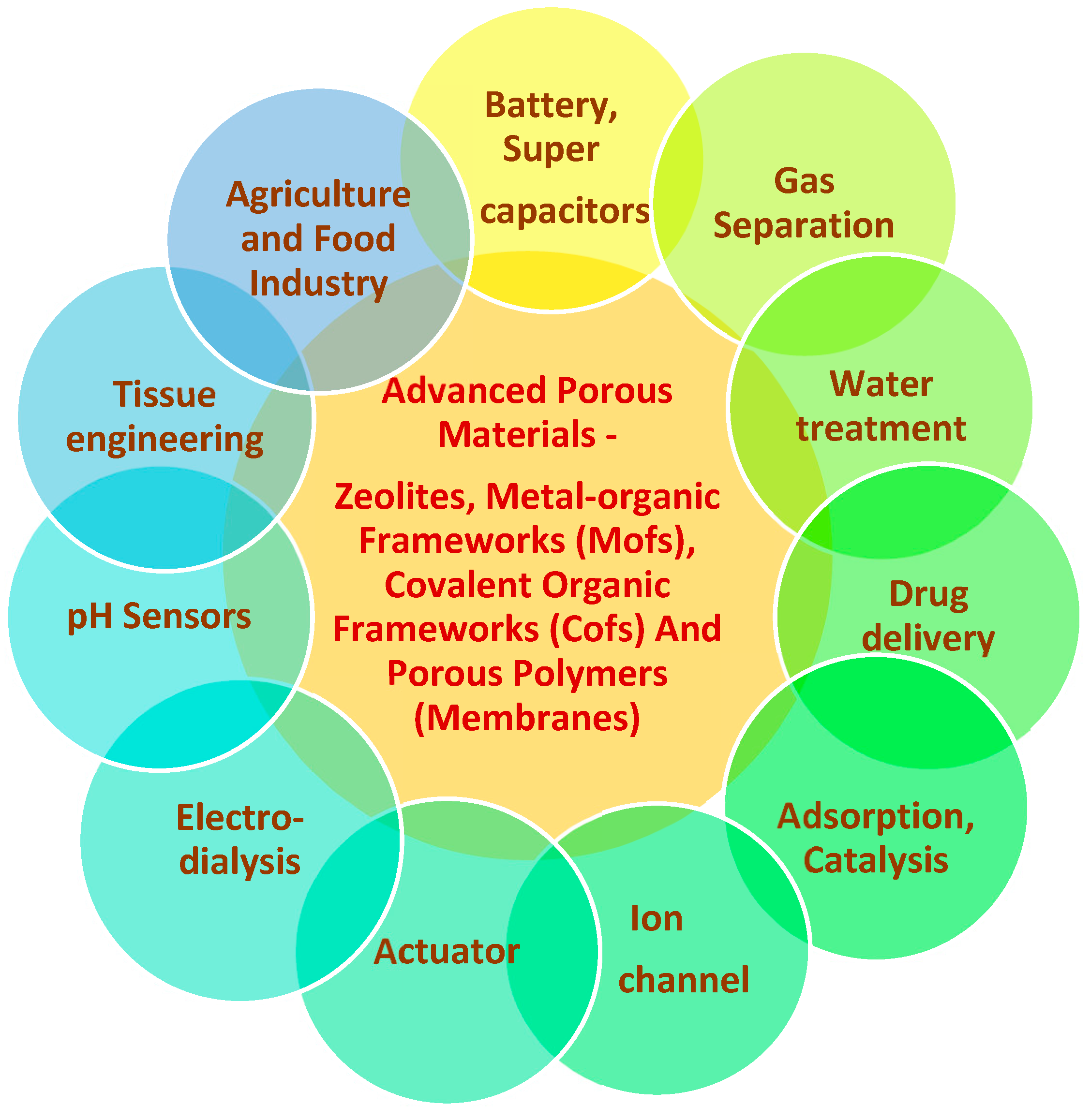
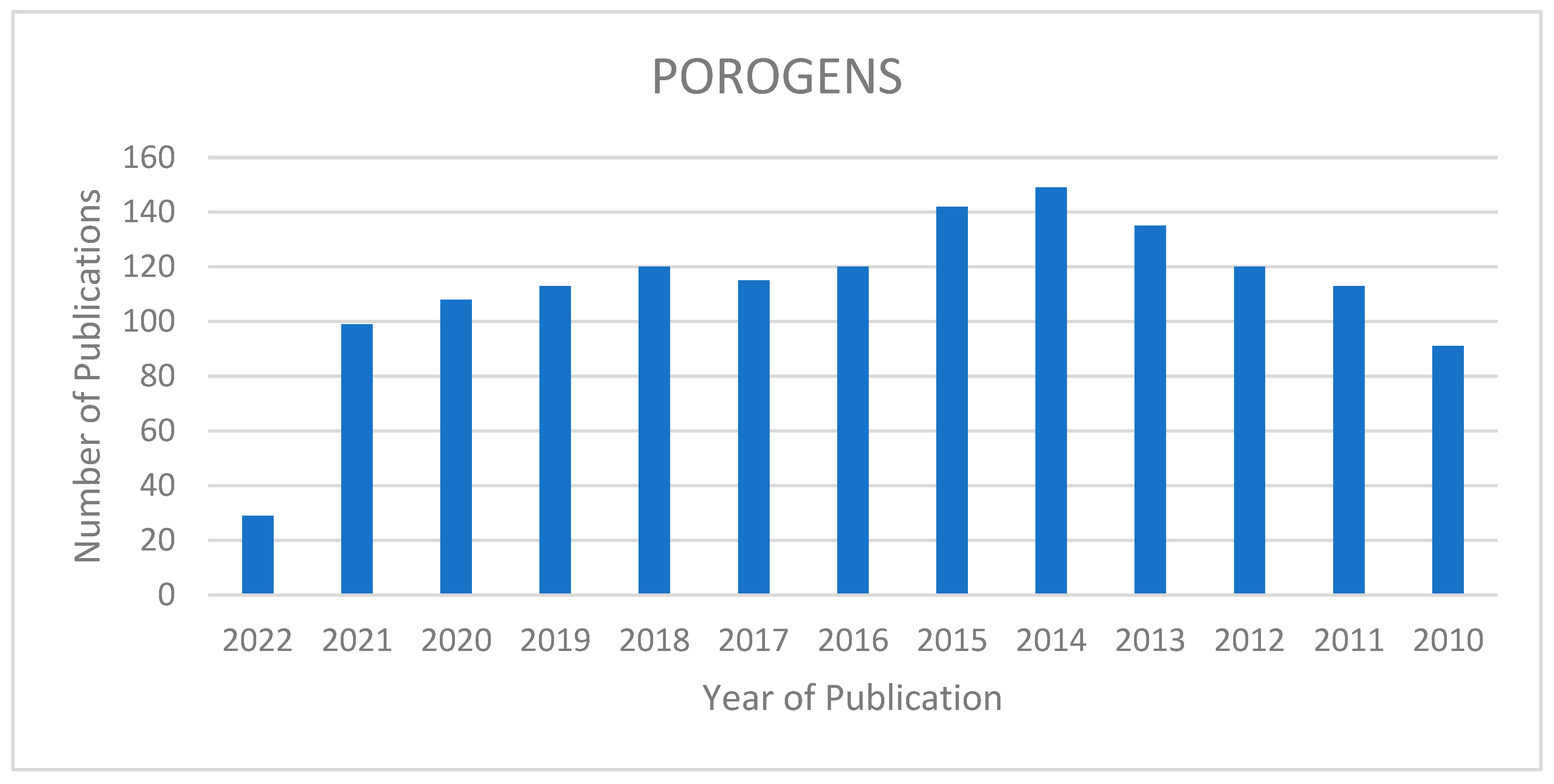


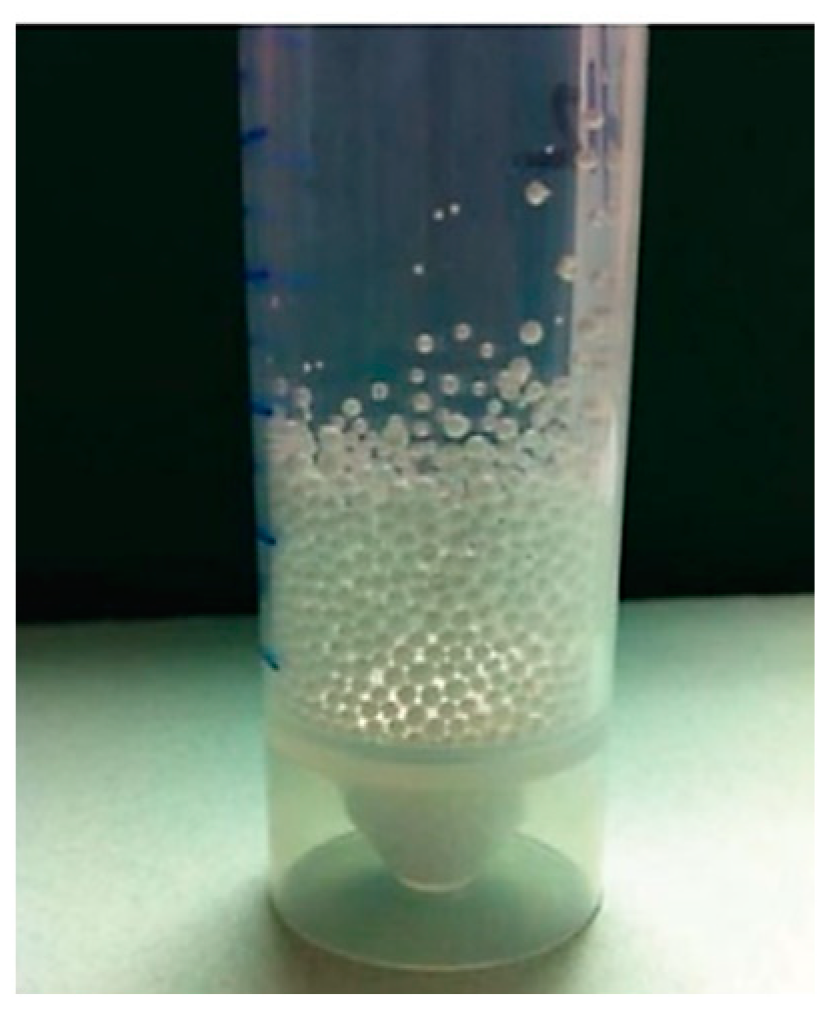




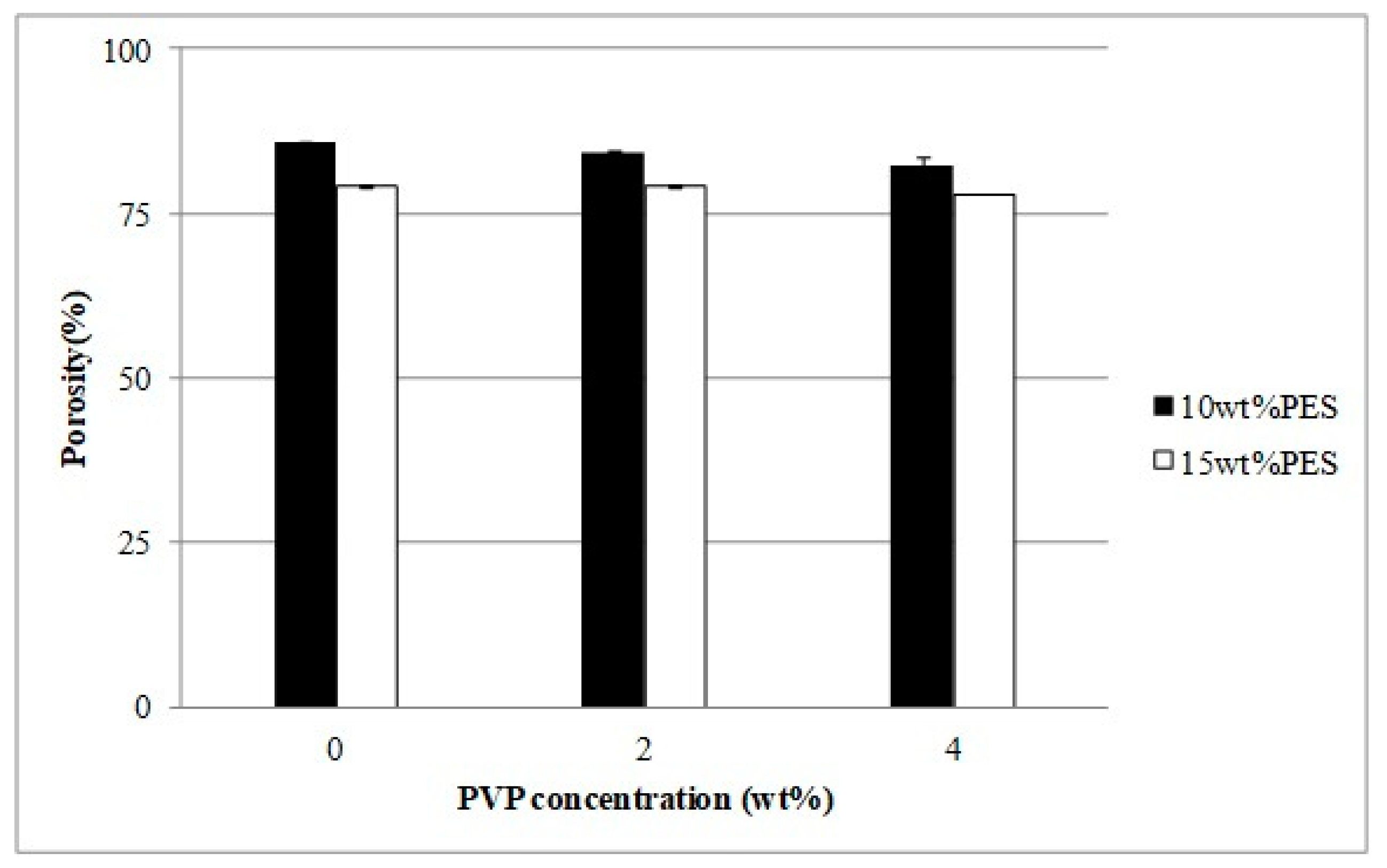

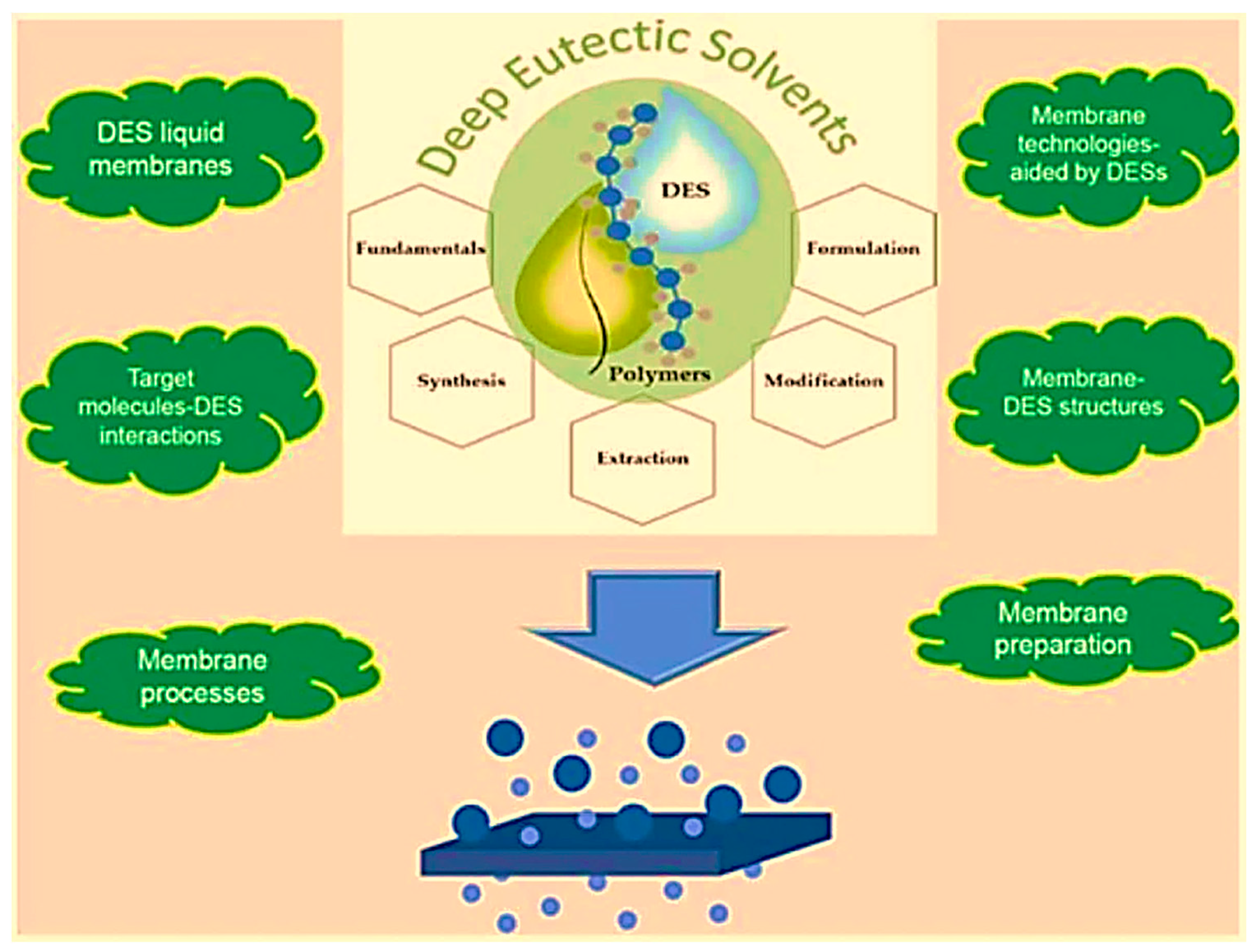
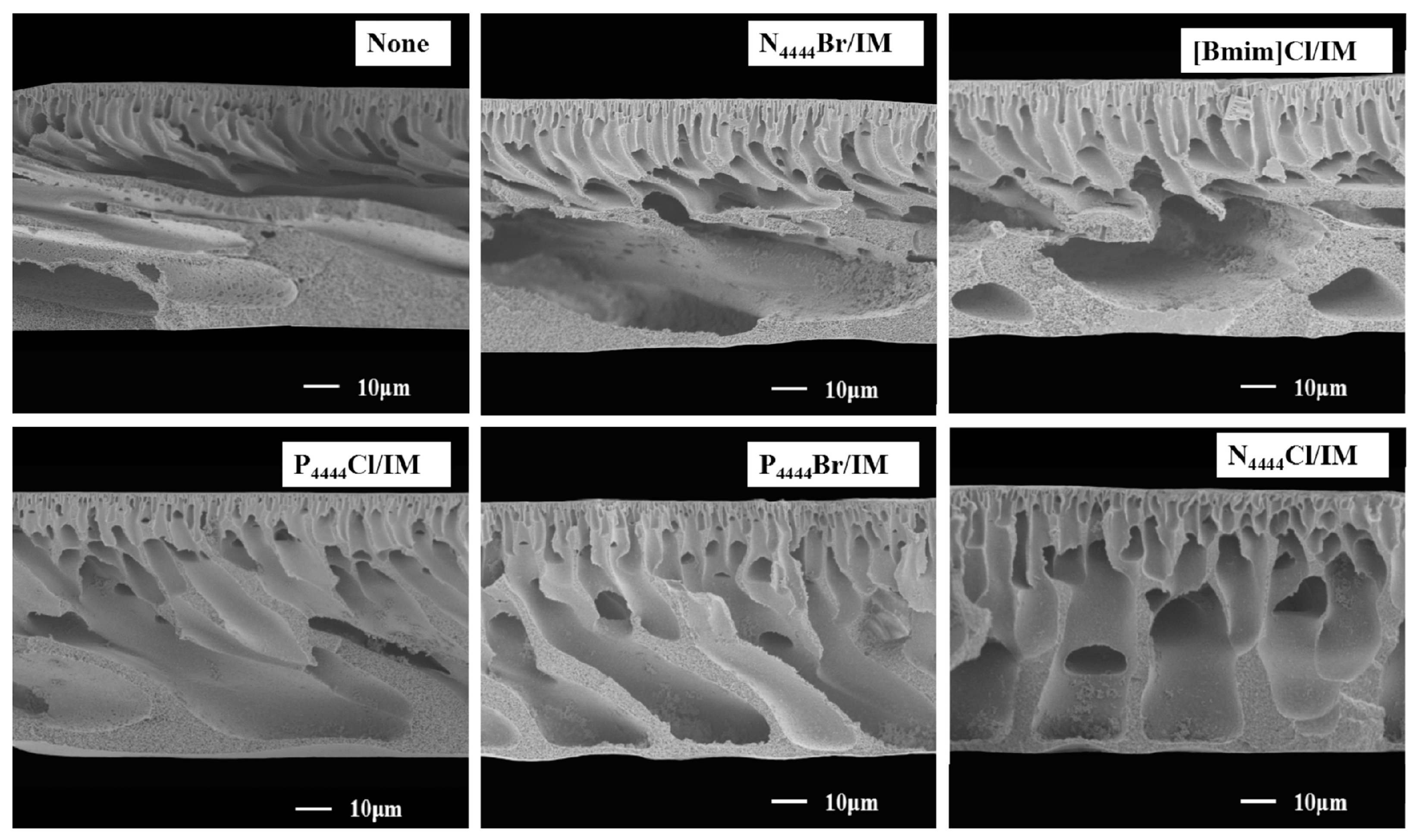
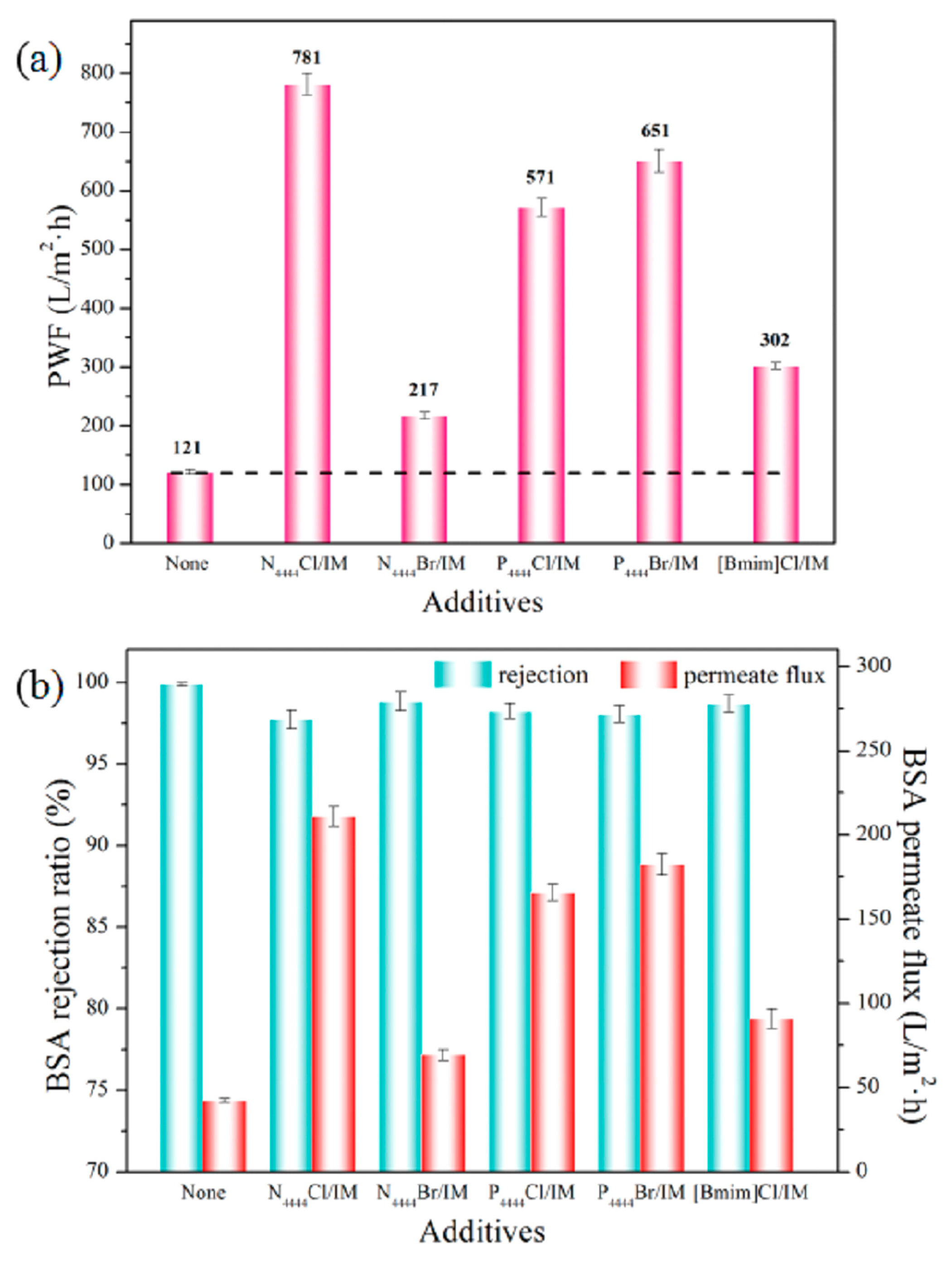

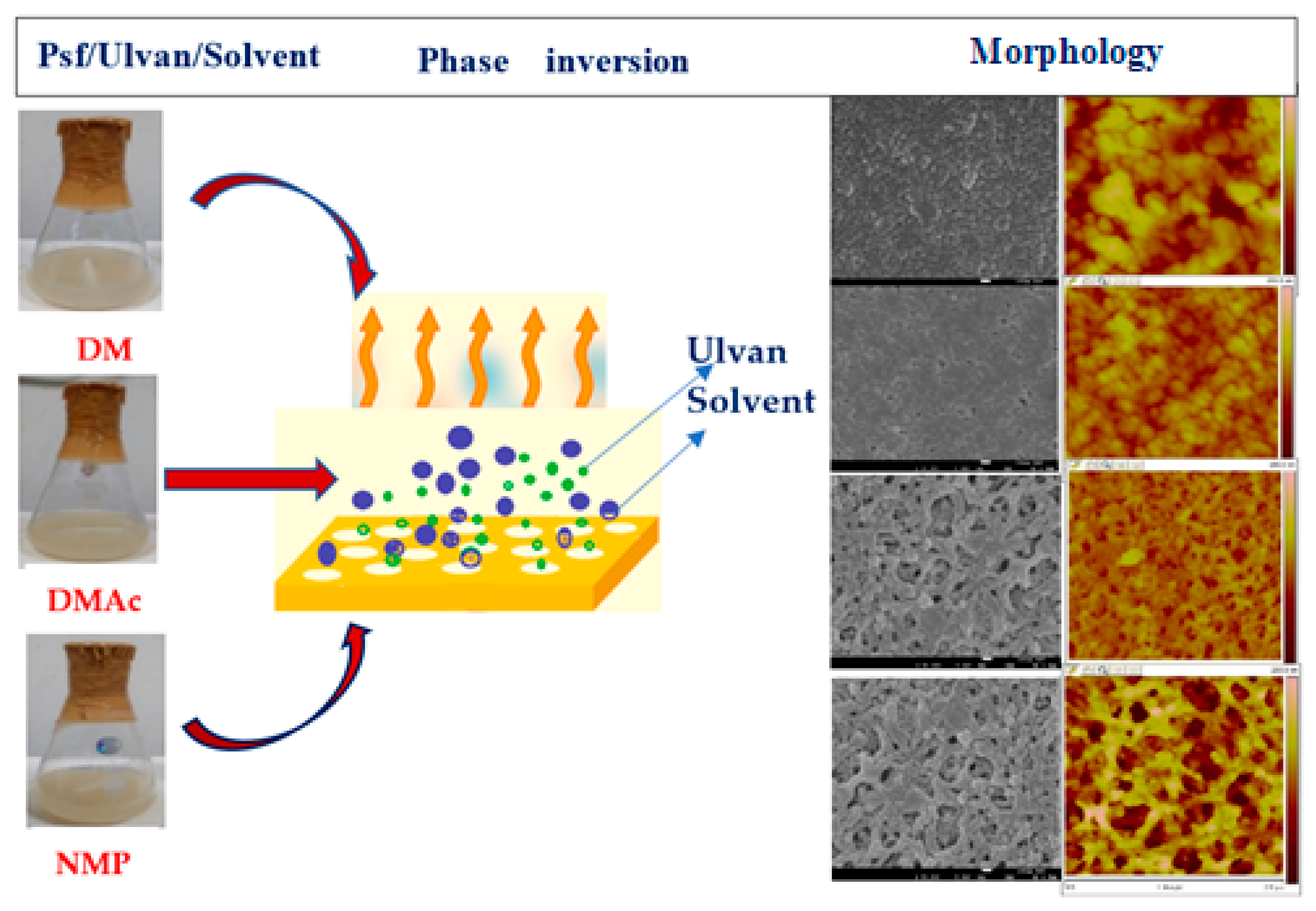
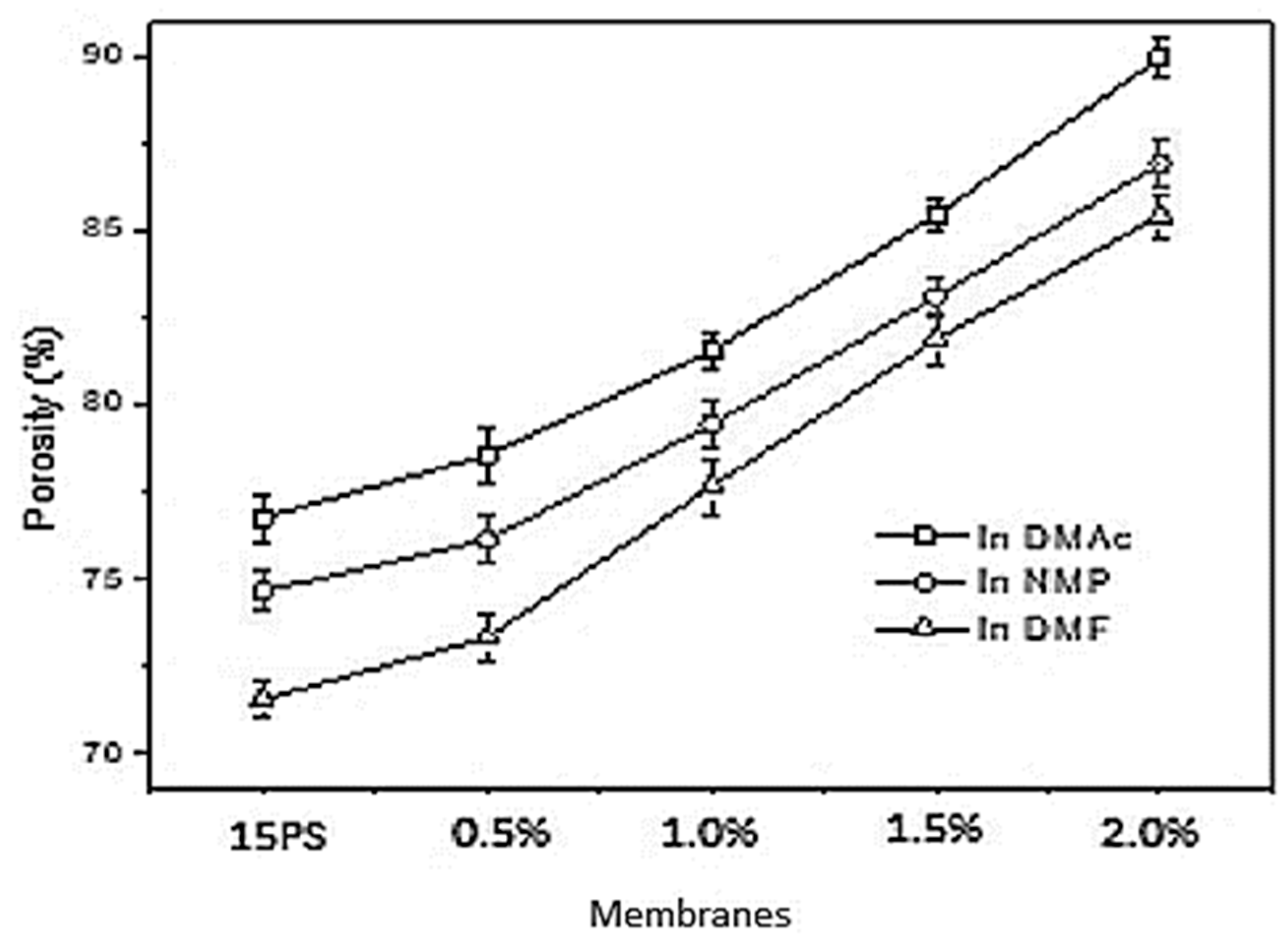
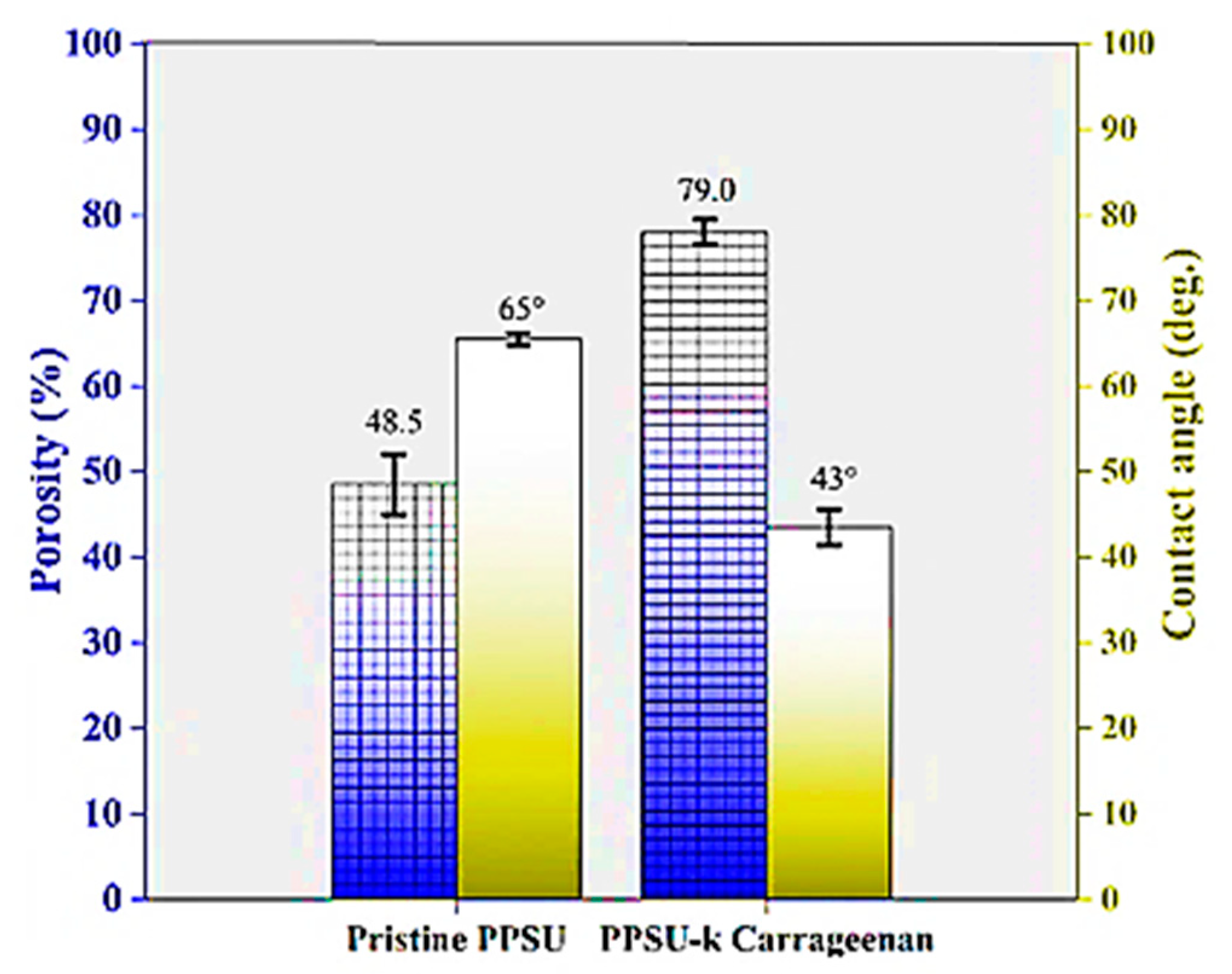

| S. No. | Porogens Used | Functions | Applications |
|---|---|---|---|
| 1. | Water-soluble polymers such as Polyethylene glycol (PEG), poly(vinylpyrrolidone) (PVP), Polyvinyl alcohol (PVA), etc. | Increases mean pore size distribution, membrane porosity and hydrophilicity. | Water filtration. Pharmaceutical and biomedical applications, fuel cell applications, etc. |
| 2. | Low molecular weight inorganic salts: Lithium chloride, Zinc chloride, SiO2, etc. | Good adsorption capabilities, high transparency, easy regeneration | Enhanced heterogeneous photocatalysts and their application to various reactions for organic pollutant removal from air and water |
| 3. | Calcium Carbonate | Improved the apparent porosity and enlarged the pore size with good mechanical strength | High apparent porosity ceramics |
| 4. | Ammonium bicarbonate | Enhanced porosity and show more uniform pore distribution Well interconnected macroporous scaffolds were produced having mean pore diameters of around 300–400 μm | Shape memory alloys Highly open porous biodegradable scaffolds for tissue regeneration [8] |
| 5. | Waste biological resource such as saw dust, potato, wheat, corn, rice starch, etc. Corncob bio char from K2FeO4 and KOH | Reduction composition of pore former results in reduction in membrane pore size and porosity. Porosity also depends on thermal conductivity Good capacitance equivalent to graphene materials | Microfiltration and microbial filtration applications. Burners, anodes, thermal barrier coatings and insulating layers. Capacitive deionization plate materials or electrodes |
| 6. | Fire clay bricks—wastes from renewable or mineral resources | Porosity, water absorption, density, mechanical resistance and even thermal insulation is enhanced and modified. | Innovative building materials |
| 7. | Carbon black Activated carbon from the palm oil shell | Pores were helpful for enhancing the strength and decreasing the thermal conductivity Pore formers increase the porosity and pore volume Shown best membrane permeability | Alumina porous ceramics Proton exchange membrane fuel cells Peat water microfiltration |
| 8. | Naphthalene, carbon beads or fibers polymers such as PMMA (polymethylmethaacrylate), polyurethane, cellulose and paraffin oil | Porosities up to 90% with pores ranging from 1 to 2000 mm in size are reported | Drug delivery and manufacturing of 3D scaffolds with desired porosity |
| 9. | Biodegradable polymer: Chitosan | Produced anodes with lower fracture strength and modest electrical conductivity | Solid oxide fuel cells |
| 10. | Marine source seaweed polysaccharides: κ- Carrageenan | Continuous porous structure with uniformly distributed pores was obtained. It also increased the membrane porosity and mean pore diameter increased | Membranes for various applications |
| 11. | Marine source seaweed polysaccharides: Alginate | Showed a high porosity and an open porous structure | 3D Porous hydrogel as meniscus substitute |
| 12. | Marine source seaweed polysaccharides: Ulvan | Very high influence on the efficiency and morphological properties | Ultrafiltration membranes |
| S. No. | Nature of the Membranes | Inorganic Porogens Used | Properties Tuned | Applications |
| 1. | Thin-film nanocomposite (TFN) membranes | SiO2 nanoparticles | Higher water permeability, high water flux and better salt rejection | Forward osmosis [9] |
| 2. | Amine functionalized multi-walled carbon nanotubes (F-MWCNTs) | Forward osmosis [10] | ||
| 3. | TiO2 nanoparticles | Higher water permeability and low reverse solute flux | Forward osmosis [11] | |
| 4. | Porous zeolite nanoparticles | Higher water permeability and high water flux | Forward osmosis [12] | |
| 5. | NaY zeolite nanoparticles | Forward osmosis [13] | ||
| 6. | Metal matrix membranes | Silica gel | Higher water permeability, high water flux and better salt rejection | Forward osmosis [14] |
| Inorganic Materials | Membrane Type | Polymer | PWF (L/m2 h bar) | Refs. |
|---|---|---|---|---|
| Iron–Nickel oxide | NF | PES | 2.20 | [23] |
| Metformin/GO/Fe3O4 | NF | PES | 9.02 | [24] |
| Chitosan–Montmorillonate | Loose NF | PES | 15.60 | [25] |
| CNT | NF | PES | 10.66 | [26] |
| Sulfonated halloysite nanotube | Loose NF | PES | 17.00 | [27] |
| SiO2/LiCl | UF | CA | 18.06 | [28] |
| SiO2/PEG600 (inorganic/organic) | UF | CA | 23.48 | [28] |
| LiF | UF | PES | 100.00 | [21] |
| LiCl | UF | PES | 82.00 | [21] |
| LiBr | UF | PES | 43.00 | [21] |
| Clay/LiCl | UF | PSf | 263.00 | [29] |
| LiCl | RO | Aromatic Polyamide Membranes | 34.00 | [22] |
| LiClO4 | RO | Aromatic Polyamide Membranes | 42.00 | [22] |
| ZnCl2 | RO | Aromatic Polyamide Membranes | 19.00 | [22] |
| Mg(ClO4)2 | RO | Aromatic Polyamide Membranes | 38.00 | [22] |
| ZnCl2+ Pyridine Hydrochloride (inorganic/organic salt) | RO | Aromatic Polyamide Membranes | 46.20 | [22] |
| Mg(ClO4)2 + Pyridine Hydrochloride (inorganic/organic salt) | RO | Aromatic Polyamide Membranes | 189.00 | [22] |
| S. No. | Water Soluble Porogens | Structure | Polymers and Membranes | Properties Enhanced |
|---|---|---|---|---|
| 1 | PEG | 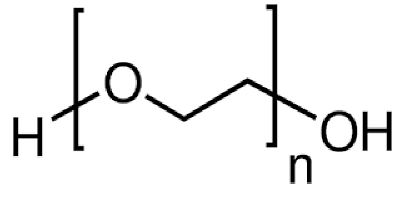 | Modified cellulose acetate UF membrane | Porosity/permeability of membrane increased [30] |
| Asymmetric CA membranes | Increased pure water flux and macro-void formation [31] | |||
| PEI membrane | Altered membrane morphology and larger average pore radius [32] | |||
| PVC UF membranes | High water flux, excellent thermal stability and mechanical strength | |||
| 2 | PVP | 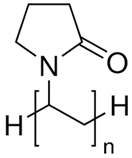 | PVDF hollow fiber membrane | Effective porosity, consistent mean pore size [33,34,35] |
| PEI hollow fiber membrane | Larger pore size [36,37] | |||
| PES hollow fiber membrane | Enhancement of water flux [38] | |||
| PES UF membrane | Membrane permeability [39] | |||
| 3 | PVA | 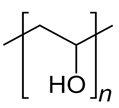 | Alumina | Enhanced porosity [40] |
| Adsorptive polymer chitosan conjugate | Heavy water removal [41] | |||
| Ethyl cellulose film coated pellets | Increased drug dipyridamole release [42] | |||
| PVA membranes | Separation of CO2 from water [43] | |||
| 4 | PAM | 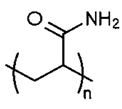 | Ceramic membranes | Alters the membrane pore size and membrane flux [44] |
| Chitosan–PAM membrane | Thermal stability of the membrane enhanced [45] | |||
| Poly(ether ether ketone) (PEEK-WC) membrane | Decreased hydrophobicity | |||
| PAM–polydivinylbenzene membranes | Enhanced pH stability and separation factor | |||
| 5 | PAA | 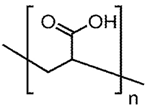 | PI membranes | Enhancement of porosity [46] |
| PSf membrane | Increased rejection of lead and sulphur dyes [47] | |||
| Nylon 6, six composite membranes | Improved flux rate and separation factor [48] | |||
| Microporous membrane with polypropylene | Chemical valve effect on flux by varying pH [49] | |||
| 6 | HPMA |  | HPMA-PSf membrane | Effective boron removal [50] |
| PS-b-HPMA membrane | Enhanced pore size and water flux [51] | |||
| Bisphosphonate-derived ligand membrane | Improved flexibility of the copolymer ligand and superior specific protein adsorption [52] | |||
| Amphiphilic p(HPMA)-co-p(LMA) polymeric membrane | Hydrophobic interactions of lipids were prevented and membrane proteins incorporation were allowed [53] |
Publisher’s Note: MDPI stays neutral with regard to jurisdictional claims in published maps and institutional affiliations. |
© 2022 by the authors. Licensee MDPI, Basel, Switzerland. This article is an open access article distributed under the terms and conditions of the Creative Commons Attribution (CC BY) license (https://creativecommons.org/licenses/by/4.0/).
Share and Cite
Lakshmi, D.S.; K. S., R.; Castro-Muñoz, R.; Tańczyk, M. Emerging Trends in Porogens toward Material Fabrication: Recent Progresses and Challenges. Polymers 2022, 14, 5209. https://doi.org/10.3390/polym14235209
Lakshmi DS, K. S. R, Castro-Muñoz R, Tańczyk M. Emerging Trends in Porogens toward Material Fabrication: Recent Progresses and Challenges. Polymers. 2022; 14(23):5209. https://doi.org/10.3390/polym14235209
Chicago/Turabian StyleLakshmi, D. Shanthana, Radha K. S., Roberto Castro-Muñoz, and Marek Tańczyk. 2022. "Emerging Trends in Porogens toward Material Fabrication: Recent Progresses and Challenges" Polymers 14, no. 23: 5209. https://doi.org/10.3390/polym14235209
APA StyleLakshmi, D. S., K. S., R., Castro-Muñoz, R., & Tańczyk, M. (2022). Emerging Trends in Porogens toward Material Fabrication: Recent Progresses and Challenges. Polymers, 14(23), 5209. https://doi.org/10.3390/polym14235209







